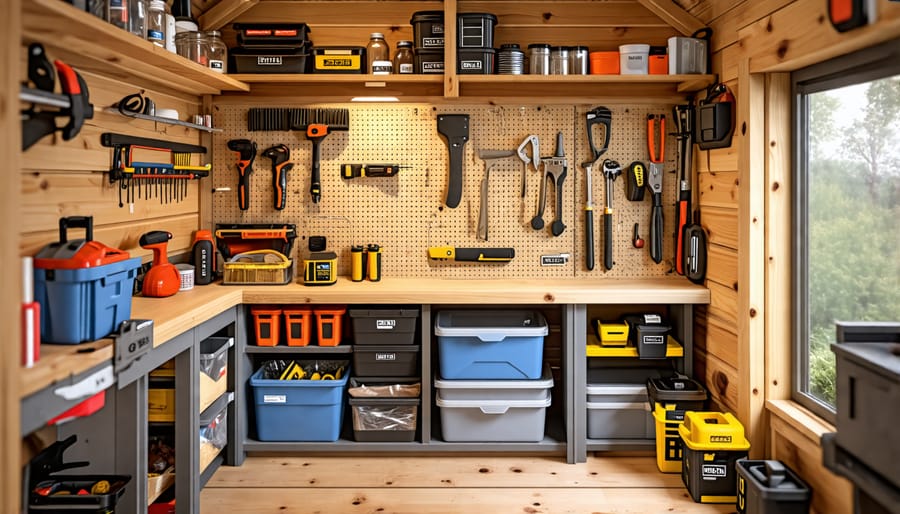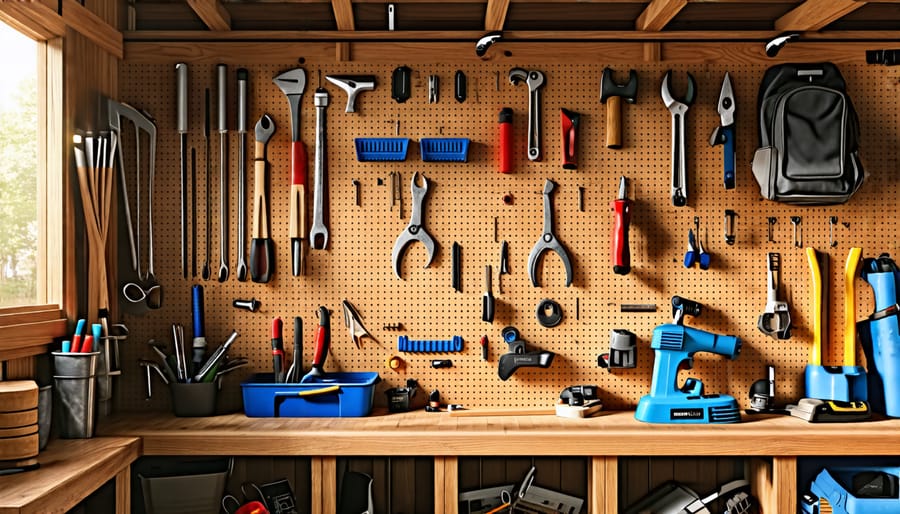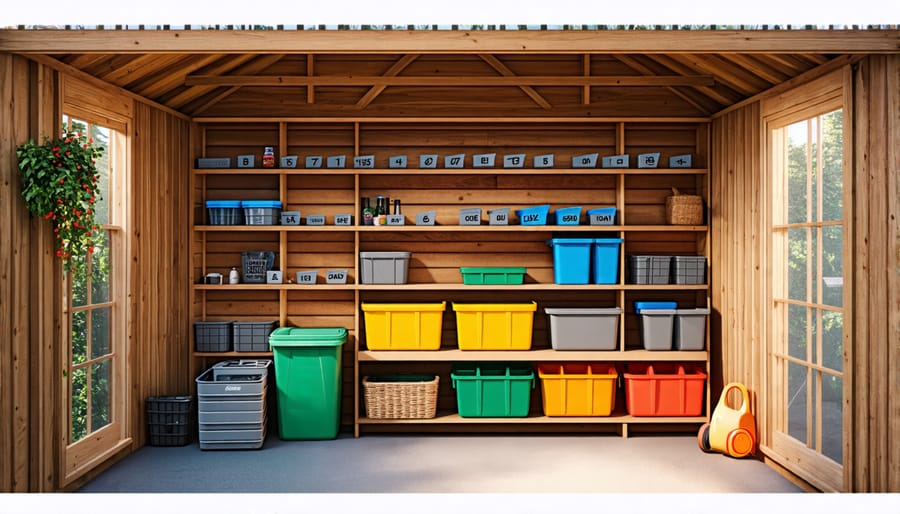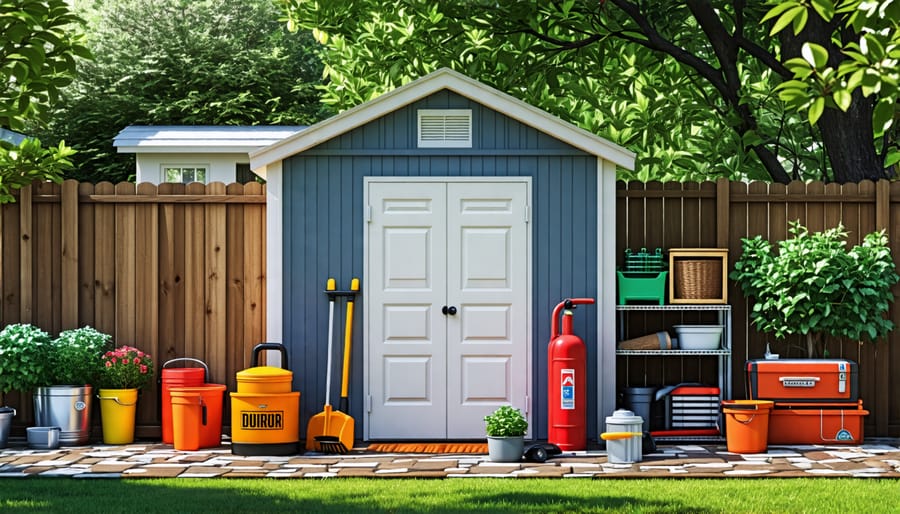9 Clever Ways to Organize Your Small Shed (And Find Everything Easily!)

Maximize vertical space with pegboards, shelving units, and hanging organizers to keep tools and supplies easily accessible. Implement a clear labeling system for storage bins and containers to quickly locate items when needed. Utilize wall-mounted magnetic strips for organizing small metal objects like nails, screws, and drill bits. Invest in a workbench with built-in drawers and cabinets to create a designated space for projects and organizing a shed.
Maximizing Vertical Space
Pegboard Power
Installing a pegboard is a game-changer for small shed organization. Start by choosing a wall that’s easily accessible and has enough space for your tools. Secure the pegboard to the wall studs using screws, ensuring it’s level and firmly attached. Next, invest in a variety of hooks, brackets, and bins that fit your specific tools and equipment. Arrange your items by grouping similar tools together and placing frequently used items at eye level for quick access. Utilize the versatility of a pegboard by adjusting the layout as your needs change. With a well-organized pegboard, you’ll never waste time hunting for a misplaced tool again.

Shelving Solutions
Maximize storage in your small shed with clever shelving solutions. Wall-mounted shelves are a great option, utilizing vertical space without encroaching on floor area. Consider adjustable wire shelving units that can be customized to fit your needs. Pegboards are another versatile choice, allowing you to hang tools and accessories using hooks and baskets. For a more aesthetically pleasing look, opt for floating shelves made of wood or metal. Over-the-door organizers and hanging shoe racks can also be repurposed for storing smaller items. Don’t forget to take advantage of the ceiling by installing overhead storage racks for bulky or seasonal items. By implementing these ingenious shed organization hacks, you’ll create a clutter-free and efficient storage space that maximizes every inch of your small shed.
Smart Floor Planning
Creating Zones
To make the most of your small shed’s space, create distinct zones based on item category or frequency of use. Dedicate areas for gardening tools, sports equipment, seasonal decorations, and other groups of items. Frequently used items should be placed in easily accessible zones near the entrance, while less-used items can be stored in harder-to-reach areas. Use labeled shelves, bins, or pegboards to define each zone and keep items organized within their designated spaces. By establishing clear zones, you’ll be able to quickly locate what you need and maintain a tidy shed interior.
Labeling for Easy Access
Clear labeling is essential for keeping your small shed organized and easily accessible. By clearly identifying the contents of each storage container, shelf, or area, you’ll save time and frustration when searching for specific items. Invest in a label maker or use adhesive labels and a permanent marker to create neat, readable labels. For shelves, consider using hanging tags or clip-on labels to identify the contents. Color-coding your labels can also help you quickly locate items by category. Don’t forget to label the outside of your shed with a list of the main categories stored inside for at-a-glance convenience.

Repurposing Household Items
Got it, here’s the content for the “Repurposing Household Items” section, targeting around 300 words and incorporating the writer’s profile guidelines:
When it comes to organizing your small shed on a budget, a little creativity goes a long way. Before heading to the store, take a look around your home for everyday items that can be repurposed into handy storage solutions. Glass jars of various sizes, for example, make excellent containers for sorting and storing small parts like nails, screws, and washers. Label each jar clearly to keep your workshop well-organized and save time on projects.
Have an old hanging shoe caddy taking up space in your closet? Give it new life in the shed by using it to store garden tools, gloves, and seed packets. The clear pockets make it easy to find what you need at a glance, while keeping your supplies off the floor and easily accessible.
Towel bars aren’t just for the bathroom – they can also help corral awkward items in the shed. Install a few on the walls or behind the door to hang coiled hoses, extension cords, or even a dustpan and brush set. This simple hack keeps your tools tidy and off the ground, making the most of your shed’s vertical space.
Other household items that can find a second home in your shed include:
– Magnetic knife strips for holding small tools
– Pegboard for customizable wall storage
– Leftover PVC pipes for organizing long-handled tools
– Spice racks for storing small hardware or craft supplies
– Hanging fruit baskets for corralling sports equipment or garden gloves
By thinking outside the box and repurposing items you already own, you can create an organized and efficient shed without breaking the bank. Embrace your inner DIYer and let your imagination run wild – your tidy and functional shed will thank you!
[Word count: 290]

Investing in Multi-Purpose Storage
When it comes to maximizing storage space in your small shed, investing in multi-purpose storage solutions is a smart move. Versatile pieces like mobile workbenches with built-in drawers offer the perfect blend of functionality and space-saving design. These handy units provide a sturdy work surface for your projects while keeping tools and supplies neatly organized in the drawers below. Stackable bins are another great option, allowing you to make the most of vertical space and keep items easily accessible. Consider clear plastic bins so you can quickly identify contents without having to rummage through each one. Rolling carts, equipped with casters for effortless mobility, are ideal for storing frequently used items like gardening tools or power equipment. These multipurpose storage solutions not only help you maximize storage space but also make your shed a more efficient and enjoyable workspace. By choosing items that serve multiple functions, you’ll be able to create a clutter-free environment that caters to your specific needs and makes the most of every square inch.
Implementing a Cleanup Routine
Maintaining a clutter-free shed is essential for long-term organization and functionality. Set aside time each month to tidy up and put things back in their designated spots. Start by removing any items that don’t belong in the shed and disposing of broken or unused tools. Sweep the floor and wipe down surfaces to keep the space clean and pest-free. Check for any signs of damage or leaks and address them promptly to prevent further issues. As you return items to their proper places, take note of any storage solutions that may need to be adjusted or replaced. By establishing a regular cleanup routine, you’ll ensure that your shed remains a well-organized and efficient workspace for years to come. Remember, a little bit of maintenance goes a long way in keeping your shed tidy and functional.
Conclusion
In conclusion, implementing these small shed organization ideas can transform your cluttered storage space into a functional and visually appealing area. By utilizing vertical storage, creating designated zones, and investing in versatile containers, you’ll maximize every inch of your shed while improving accessibility to your tools and equipment. Remember to regularly maintain your organizational system by decluttering and returning items to their designated spots after use. With a well-organized shed, you’ll save time, reduce stress, and enjoy a more efficient and productive workspace for all your DIY projects and outdoor activities. Embrace these strategies and take pride in your newly organized small shed!

